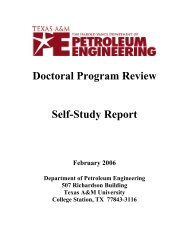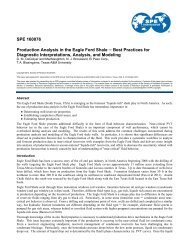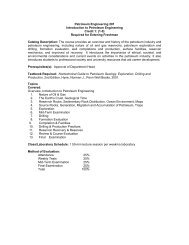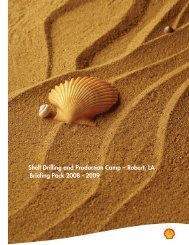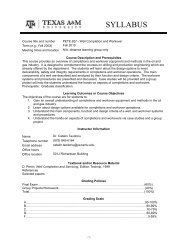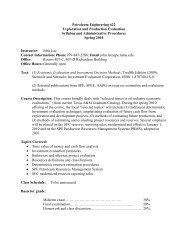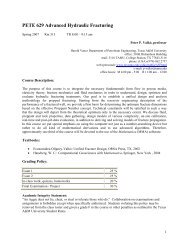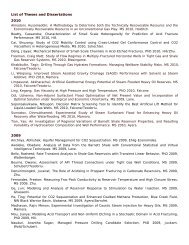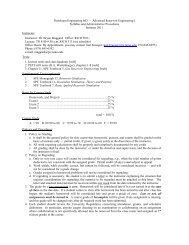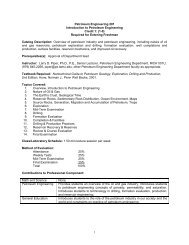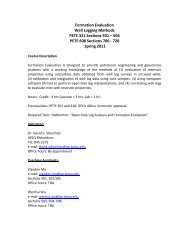Crisman Annual Report 2009 - Harold Vance Department of ...
Crisman Annual Report 2009 - Harold Vance Department of ...
Crisman Annual Report 2009 - Harold Vance Department of ...
You also want an ePaper? Increase the reach of your titles
YUMPU automatically turns print PDFs into web optimized ePapers that Google loves.
Stochastic History Matching, Forecasting, and Production with the Ensemble<br />
Kalman Filter<br />
Introduction<br />
The data assimilation process <strong>of</strong> adjusting variables<br />
in a reservoir simulation model to honor observations<br />
<strong>of</strong> field data is known as ‘history matching’ and<br />
has been extensively studied for few decades.<br />
However, despite the progress that has been made,<br />
development <strong>of</strong> more accurate and efficient history<br />
matching techniques that produce geologically<br />
realistic outcomes (reservoir models) is still one<br />
<strong>of</strong> the main challenges for reservoir engineers,<br />
mainly due to the high complexity <strong>of</strong> the problem,<br />
data scarcity, and computational demand for field<br />
applications. Because <strong>of</strong> the insufficient information<br />
about reservoir spatial property distribution,<br />
history matching <strong>of</strong> heterogeneous reservoirs is<br />
an inherently ill-posed inverse problem; that is,<br />
it is possible to obtain several reservoir models<br />
that honor observed measurements but have<br />
geologically distinct features and provide incorrect<br />
predictions. Two common approaches to deal with<br />
ill-posed history matching problems are either to<br />
constrain the structural form <strong>of</strong> acceptable solutions<br />
(regularization) or to reduce the number <strong>of</strong> unknown<br />
parameters (reparameterization). While these<br />
methods have been successfully used as effective<br />
strategies to improve the solution <strong>of</strong> ill-posed inverse<br />
problems, they may not provide accurate solutions<br />
where a simple structural assumption can be defined<br />
for features with more complex geometry.<br />
for incorporating dynamic flow measurements into<br />
multipoint pattern simulation with the Single Normal<br />
Equation SIMulation (SNESIM) algorithm.<br />
Accomplishments<br />
The generated probability map represents the main<br />
information in the nonlinear dynamic measurements<br />
and can be easily integrated into the SNESIM<br />
algorithm to simulate an updated ensemble <strong>of</strong><br />
conditional facies (Fig. 1b). We have illustrated<br />
the effectiveness <strong>of</strong> this approach through several<br />
experiments. The results <strong>of</strong> development have been<br />
summarized into a manuscript that is currently<br />
being reviewed in the Computational Geosciences<br />
Journal. Figure 1 shows a simple example from the<br />
manuscript that is undergoing review.<br />
Future Work<br />
We are currently working to advance the<br />
implementation <strong>of</strong> our approach to deal with<br />
uncertainty in the training image that is used for<br />
pattern simulation and to address some <strong>of</strong> the<br />
limitations <strong>of</strong> the EnKF-based implementation <strong>of</strong> our<br />
algorithm.<br />
(continued on next page)<br />
Objectives<br />
The ensemble Kalman filter (EnKF) has recently<br />
been introduced to reservoir engineering literature<br />
as a promising history matching technique. It is easy<br />
to implement, provides considerable flexibility for<br />
describing reservoir model uncertainty, and supplies<br />
valuable information about reservoir performance<br />
prediction uncertainty. Among the limitations <strong>of</strong> the<br />
EnKF is its covariance-based (second order) model<br />
updating scheme that restricts its application to<br />
estimate discrete geological objects that are not<br />
amenable to covariance-based descriptions. When<br />
the standard EnKF implementation is used to update<br />
facies permeability values in each grid block (Fig.<br />
1a), the connectivity between the existing features<br />
is not preserved even when facies description is<br />
parameterized to encourage continuity.<br />
In this project, by using the EnKF to generate a<br />
probability map to describe the spatial distribution <strong>of</strong><br />
facies, we are developing a more consistent approach<br />
<strong>Crisman</strong> <strong>Annual</strong> <strong>Report</strong> <strong>2009</strong><br />
CRISMAN INSTITUTE<br />
Project Information<br />
3.6.6 Stochastic History Matching, Forecasting, and<br />
Production with the Ensemble Kalman Filter<br />
Contacts<br />
Behnam Jafarpour<br />
979.845.0666<br />
behnam.jafarpour@pe.tamu.edu<br />
Morteza Khodabakhshi<br />
79



